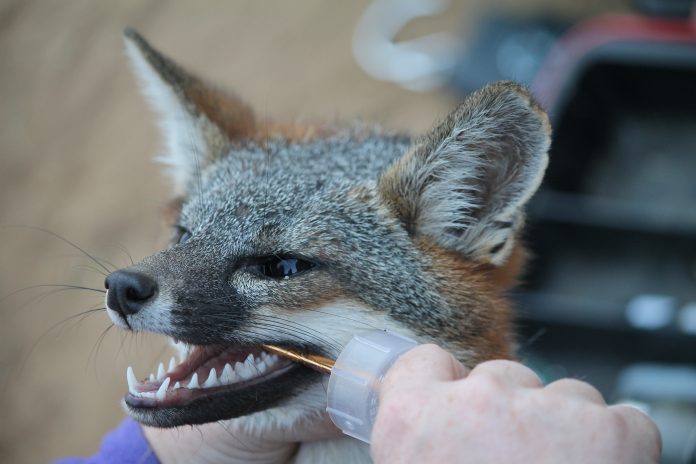Conservancy monitors the health of the endemic Catalina Island fox population
Traveling along a dirt road on the West End of Catalina Island, biologists with the Catalina Island Conservancy keep a sharp eye out for marks that indicate a fox trap. After pulling to the side of the road and hiking to spot the well-hidden cage, the real work begins.
“We’ve got a fox,” Conservancy Biologist Emily Hamblen calls softly, so as not to startle the animal.
Welcome to fox trapping season.
Each year, the Conservancy monitors the health of the endemic Catalina Island fox population across the Island through a six week cycle of health checks, measurements, vaccinations and tests. With a goal to inspect and vaccinate around 300 – 400 foxes, or more than 20 percent of the population, biologists work efficiently to provide services to as many animals as possible.
“This survey helps us track population trends and stay ahead of the curve – it’s the best way to ensure Catalina Island foxes stay healthy,” said Conservancy Biologist Lara Brenner.
Catalina Island foxes are lured into the safe traps using a food and berry mixture. Foxes who have already been seen this year are released, having enjoyed a nice meal, as are non-fox animals – we’re looking at you Island squirrel!
When a fox is trapped for the first time each season, biologists perform a quick examination including cleaning the eyes, which can seal closed due to dry and dusty conditions.
“This little guy has a lot of mucus in his eyes,” said Hamblen, reaching for her ‘fox kit’ full of instruments. “We can fix him up though.”
Through slow and careful cleaning, one young fox in particular gradually regained the ability to open his eyes.
Other important components include checking teeth to assess age, suggested by the wear on the upper pre-molars, and checking for and potentially medicating against fleas, ticks, and lice. Inspecting and treating the ears for mites is also on the to-do list. With some animals, biologists take blood samples to test for exposure to specific diseases.
Foxes are vaccinated against rabies and canine distemper virus. Canine distemper virus, which can be spread by domesticated dogs and wildlife such as raccoons and skunks, decimated the fox population to just 100 animals in 1999. The Conservancy, in partnership with Institute for Wildlife Studies, addressed the population crash with a three-part Fox Recovery Program that included not only vaccinations, but also captive breeding and, now, monitoring.
“It’s important to be vigilant,” said Brenner. “These viruses remain a threat.”
Case in point: Pinnacles National Park, east of Salinas Valley, Calif., released a Nov. 7 warning against a current outbreak of canine distemper, cautioning dog owners to steer clear after a gray fox tested positive for the virus.
To help keep Catalina Island foxes safe, visitors are asked to ensure that dogs are up to date on all vaccines and that there are no wildlife stowaways on boats. And to those in vehicles, remember to slow down and watch for foxes.











